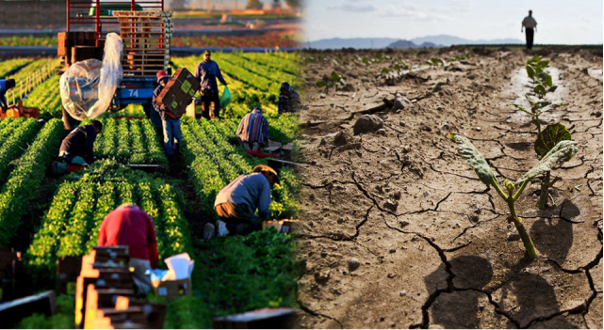
Global warming leads to climate changes worldwide, profoundly affecting agricultural production. These changes cause significant challenges in farmers' production processes and agricultural productivity.
Main Effects of Global Warming on Agricultural Production:
1. Temperature Increases
Rising global temperatures directly impact plant growth cycles and productivity. Crops sensitive to heat stress often experience stunted growth and lower yields. For example, some cereal crops can suffer damage and reduced photosynthesis rates at temperatures above 35°C, leading to yield losses. Additionally, while a longer growing season might result from higher temperatures, this isn't always beneficial. It can increase water stress and pest proliferation for some crops.
For instance, major cereal crops like corn and wheat are highly sensitive to temperature increases during critical growth stages, leading to significant yield reductions.
Solution: Developing heat-tolerant crop varieties and relocating to cooler climates are potential adaptation strategies. Genetic engineering and plant breeding techniques can create more resilient plant species. Farmers can adapt by altering planting times and experimenting with new cultivation methods. For example, planting earlier or later can help crops avoid the hottest periods.
2. Pressure on Water Resources
Increased temperatures lead to higher evaporation rates, reducing water resources. Droughts make it challenging to secure the water needed for agricultural production and increase irrigation costs. Water scarcity can pose significant problems, especially in regions that grow water-intensive crops. During droughts, issues like excessive use of groundwater and depletion of water reserves can arise.
Decreased water availability is a significant threat in major agricultural regions like India, China, the US, and Mediterranean countries. Water scarcity becomes more pronounced in areas growing water-intensive crops such as rice, cotton, and sugarcane. Additionally, the intrusion of saline water (salinity issues) can reduce crop productivity and soil fertility.
Solution: Developing water management strategies, using water-saving irrigation techniques like drip irrigation, and planting drought-resistant crop varieties are recommended. Techniques like rainwater harvesting and water reuse can also increase water savings. Improving agricultural irrigation techniques is crucial for minimizing water loss. For instance, pressure irrigation systems ensure more efficient water use. Mulching techniques and proper soil management methods also contribute to water conservation.

3. Extreme Weather Events
Global warming increases the frequency and intensity of extreme weather events such as heavy rainfall, droughts, storms, and heatwaves. These events cause crop losses and damage agricultural infrastructure.
For example, the 2010 Russian heatwave significantly reduced wheat production and raised global wheat prices. Similarly, the 2020 Australian wildfires caused severe damage to agricultural lands and livestock.
Solution: Developing agricultural insurance systems, using early warning systems, and educating farmers on extreme weather events are essential. Farmers should adopt resilient farming practices and create alternative livelihoods. For example, improving drainage systems to prevent flooding and constructing dams and water storage facilities for efficient water use during droughts may be necessary.
4. Soil Fertility
Changes in temperature and humidity can affect soil fertility. Issues like erosion, salinity, and loss of organic matter negatively impact agricultural production. As the organic matter content in soil decreases, its water-holding capacity and nutrient cycling are adversely affected.
Erosion leads to the loss of the topsoil layer, reducing soil fertility. Salinity is a significant issue, especially in areas with insufficient irrigation water. Saline water disrupts soil structure and makes it difficult for plants to absorb water.
Solution: Implementing soil conservation techniques, promoting organic farming methods, and determining fertilization strategies through soil analysis are beneficial. Techniques like reduced tillage, cover cropping, and compost use help maintain soil health. Additionally, agroforestry practices can enhance soil fertility. Practices like mulching, adding organic matter to the soil, and crop rotation are also important for preserving soil moisture.
5. Pests and Diseases
Global warming can expand the habitats of harmful insects and plant diseases. This increases crop losses and necessitates the use of agricultural chemicals. Rising temperatures and humidity can accelerate the life cycles of some pests and increase their populations.
For example, temperature increases can reduce the ability of cold weather to kill pests in winter, leading to stronger pest infestations in spring. Additionally, disease-carrying insects can spread to larger areas in warmer climates. This poses a severe threat to both plant health and agricultural production.
Solution: Using integrated pest management (IPM) methods, developing biological control strategies, and planting resistant crop varieties are recommended. IPM optimizes pest management by combining chemical, biological, and cultural control methods. Biological control uses natural predators to manage pest populations. Additionally, developing and using pest- and disease-resistant crop varieties can reduce pesticide use.
Conclusion
Global warming has significant impacts on agricultural production, and developing innovative and sustainable solutions is necessary to address these effects.
As Farmolog, we support farmers with solutions to these challenges and aim to secure agricultural production.
Contact Us for More Information and a Demo.
App Store: https://lnkd.in/dNGZTskJ
Google Play: https://lnkd.in/dTzsDWQ2

